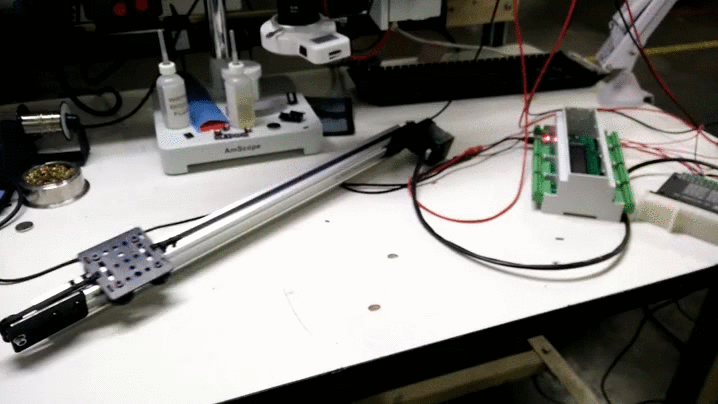Related Topics
How Soft Are Your Diodes?
Parker's pinball controller has gone gold! Revision 3 is being fabricated! Stephen then explores the softness factor of diodes and the SSPS returns?
Hungry Hungry Op Amps
Parker and Stephen just talk about Projects... Just Projects for 30 minutes.
You won’t believe this ONE WEIRD Engineering trick
Parker and Stephen talk about the Analog board of the SSPS and clickbait engineering article titles.
Other Resources
Circuit Break Podcast
Webinars
Videos
Tour MacroFab's ITAR-Compliant Facility
February 15, 2016, Episode #2
- Stephen continues his work on the Stupid Simple Power Supply (SSPS). He decided to go digital voltage control over analog. Also he has been trying out MultiSIM BLUE by Mouser for circuit simulation. See figure 1.
- Parker has been working on a X-Y gantry platform and an industrial level controller based on the Parallax Propeller P8X32A. See figure 2.
- OpenBuilds Linear Rail V-Slot.
- R/C StrandBeest. The original ones are giant monsters of kinetic art.
- Atmel releases the ATmega328PB. Has essentially double what the original 328P had. Only comes in SMT packages. Supports capacitive buttons built in which is cool!
- Parker decides that the lower the voltage a MCU can run at the better.
- Xilinx rumored to be bought by some unknown company. Stephen and Parker guess what company it is.
- To all chip and part manufactures out there, dimension to the center of pads please. Thanks.
About the Hosts

Parker Dillmann
Parker is an Electrical Engineer with backgrounds in Embedded System Design and Digital Signal Processing. He got his start in 2005 by hacking Nintendo consoles into portable gaming units. The following year he designed and produced an Atari 2600 video mod to allow the Atari to display a crisp, RF fuzz free picture on newer TVs. Over a thousand Atari video mods where produced by Parker from 2006 to 2011 and the mod is still made by other enthusiasts in the Atari community.
In 2006, Parker enrolled at The University of Texas at Austin as a Petroleum Engineer. After realizing electronics was his passion he switched majors in 2007 to Electrical and Computer Engineering. Following his previous background in making the Atari 2600 video mod, Parker decided to take more board layout classes and circuit design classes. Other areas of study include robotics, microcontroller theory and design, FPGA development with VHDL and Verilog, and image and signal processing with DSPs. In 2010, Parker won a Ti sponsored Launchpad programming and design contest that was held by the IEEE CS chapter at the University. Parker graduated with a BS in Electrical and Computer Engineering in the Spring of 2012.
In the Summer of 2012, Parker was hired on as an Electrical Engineer at Dynamic Perception to design and prototype new electronic products. Here, Parker learned about full product development cycles and honed his board layout skills. Seeing the difficulties in managing operations and FCC/CE compliance testing, Parker thought there had to be a better way for small electronic companies to get their product out in customer's hands.
Parker also runs the blog, longhornengineer.com, where he posts his personal projects, technical guides, and appnotes about board layout design and components.

Stephen Kraig
Stephen Kraig is a component engineer working in the aerospace industry. He has applied his electrical engineering knowledge in a variety of contexts previously, including oil and gas, contract manufacturing, audio electronic repair, and synthesizer design. A graduate of Texas A&M, Stephen has lived his adult life in the Houston, TX, and Denver, CO, areas.
Stephen has never said no to a project. From building guitar amps (starting when he was 17) to designing and building his own CNC table to fine-tuning the mineral composition of the water he uses to brew beer, he thrives on testing, experimentation, and problem-solving. Tune into the podcast to learn more about the wacky stuff Stephen gets up to.
Special thanks to whixr over at Tymkrs for the intro theme!
Related Podcasts

You won’t believe this ONE WEIRD Engineering trick
Parker and Stephen talk about the Analog board of the SSPS and clickbait engineering article titles.

Super Simple Buss Bars of Power
Parker and Stephen talk about the SSPS Energon Cube and Eagle Part Libraries.

Lousy Datasheet Buyouts
Stephen and Parker rant (again) on bad datasheets, ARM being bought out by SoftBank, and general project updates.

How Soft Are Your Diodes?
Parker's pinball controller has gone gold! Revision 3 is being fabricated! Stephen then explores the softness factor of diodes and the SSPS returns?

Hungry Hungry Op Amps
Parker and Stephen just talk about Projects... Just Projects for 30 minutes.

Dissolving Energon Cubes
Stephen and Parker chat about updates to the SSPS and FX Dev board.
About MacroFab
MacroFab offers comprehensive manufacturing solutions, from your smallest prototyping orders to your largest production needs. Our factory network locations are strategically located across North America, ensuring that we have the flexibility to provide capacity when and where you need it most.
Experience the future of EMS manufacturing with our state-of-the-art technology platform and cutting-edge digital supply chain solutions. At MacroFab, we ensure that your electronics are produced faster, more efficiently, and with fewer logistic problems than ever before.
Take advantage of AI-enabled sourcing opportunities and employ expert teams who are connected through a user-friendly technology platform. Discover how streamlined electronics manufacturing can benefit your business by contacting us today.

